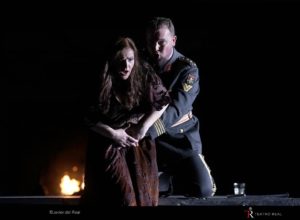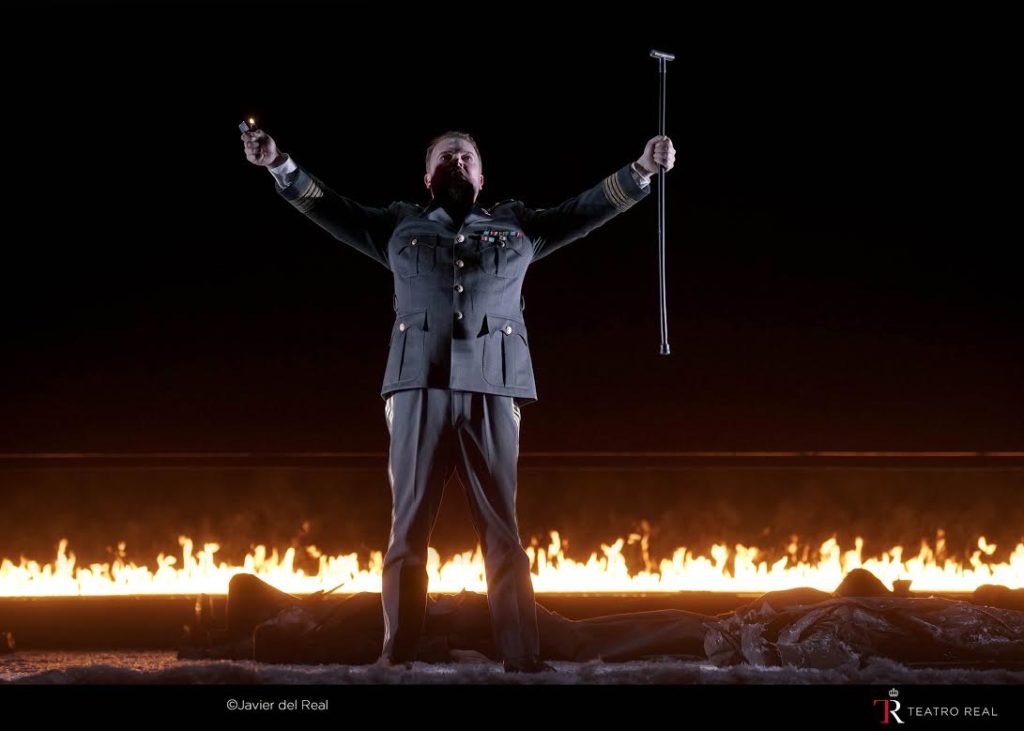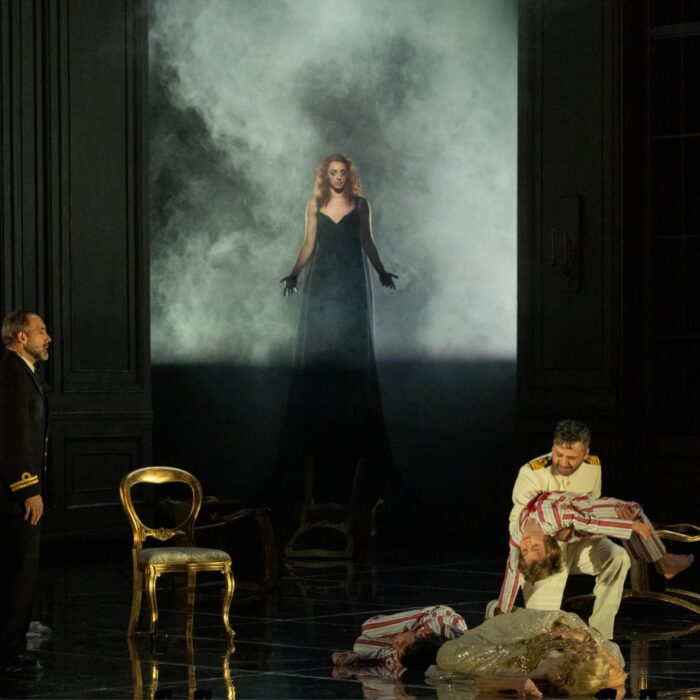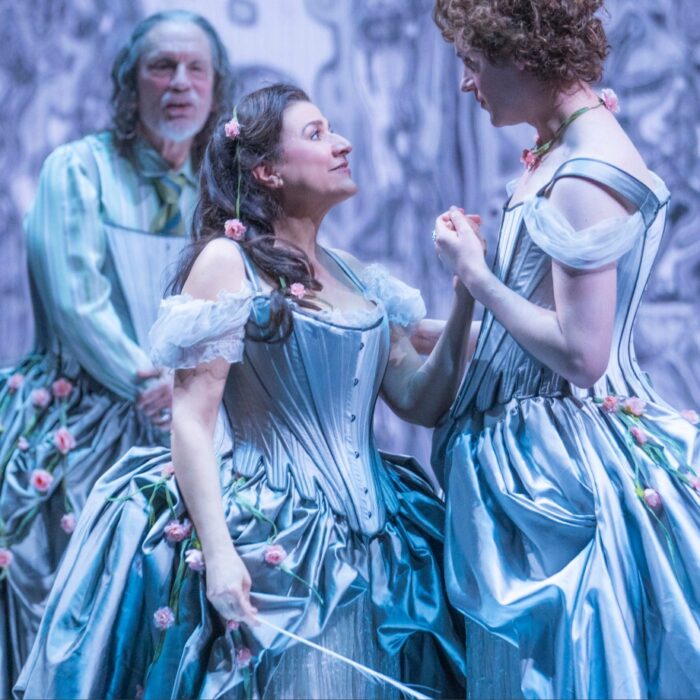
Teatro Real de Madrid 2019-20 Review: Die Walküre
Tomas Konieczny Delivers Revelatory Performance in Robert Carsen’s Exquisite Production
By Mauricio Villa(Credit: Javier del Real)
The Teatro Real de Madrid continued its staging of Wagner’s tetralogy with the second, and arguably most popular installment, “Die Walküre.” The production features the same artistic-conducting team with Robert Carsen directing and Pablo Heras-Casado on the pit.
Sadly, given that each opera of this cycle is being performed one season at a time, the casts are radically different from year to year. It is understandable that it is difficult to cast the same singers for four different seasons, but they are recording the operas to be hopefully released on home video and it is very frustrating to see different singers incarnating the same character throughout the Tetralogy. Anyway, as it happens with the first cast of “Walküre,” audiences got the opportunity to see Tomasz Konieczny as Wotan.
Under Snow
The audience was a bit confused when “Das Rheingold” ended with the gods entering the Valhalla withs now falling. It all makes sense now as “Walküre” begins with a heavy snowstorm, with a frozen white stage where a military camp is set ( Hunding’s hut).
Snow dominates the production with only the start of Act two altering the setting. It allowed Carsen to further develop his concept of an apocalyptic military world. In the third act, the Ride of the Valkyries begins with the whole stage full of frozen dead soldiers. The Valkyries kiss some of them, the chosen ones, and they get up, wander around the stage like zombies before climbing the staircases to the Valhalla. However, half of the bodies stay frozen in the snow, hidden from view by the Valkyries when Wotan appears. Brünhilde eventually falls sleep in the center of the stage surrounded by the cadavers, as the back wall rises up to show a wide line of real fire going from side to side. Wotan steps over the fire calmly and the opera ends.
The potency of Carsen’s imaginary and scenes is really effective. As in “Rheingold,” all the scenes take place inside an old industrial building. Carsen gives remarkable importance to the fire in this opera, as it is present in every act. There is a metallic drum with real fire in Act one, a big fireplace in the palace in Act two, and Brünhilde’s protective fire in Act three. And it is gladly shocking to see the contrast between the cold white snow and the warm real fire on the stage. As Carsen’s trademark, the staging relies on 45 actors who play soldiers and waiters creating a wonderful sense of dynamism in the opening scene, with some soldiers in a frenzied search for Siegmund, each holding machine guns, torch lights, and even two military dogs.
In the first scene of Act two, we see a relaxed group of soldiers having some drinks while Brünhilde lies comfortably in a sofa reading a magazine. It was truly astonishing that at the end of Act two, scene two, the center of the stage starts turning, and Sieglinde who has just awakened, turns around the stage on the jeep as a dense fog fills the stage and the confrontation between Hunding and Siegmund takes place. Carsen is so clever to use the revolving stage just in this moment, creating general surprise, rather than overusing the effect as other directors usually do.
But there are lots of moments of slow, dense action in the opera, like Wotan’s monologue, the “Todesverkündigung,” or the Wotan-Brünhilde duet in Act three. It is here where Carsen uses his theatrical talent to direct every single reaction of the characters, with nothing is left out, making the scenes dramatic, meaningful, and moving. You might agree or disagree with Carsen’s concept, but he is a true stage director and his productions have always had an amazingly high quality. You leave the theatre wishing you could see the next two operas right away.

Two Sides of a Coin
Tomas Konieczny was a revelation as Wotan. This bass-baritone has incredible control and volume, something indispensable in this role with a very ample register. Wotan is a difficult role to sing because his tessitura ranges from low F to high G flat. From his very first entrance on “Reite zur Wal,” he delivered his first long sustained F sharp (which happens in his third singing line with no possibility to warm up the voice on the stage) and demonstrated how easily he could surpass the density of Wagner’s strong orchestration.
But the role is not only about loud high notes and his interpretation of his long monologue in Act two was full of detailed dynamics, making this impossibly long scene intense and thrilling. The second “Geb” when he kills Hunding was menacing and frightening.
But the highlight of his performances was his last duet with Brünnhilde and monologue in Act three. After his ferocious entrance where his voice reflected his anger and frustration, he made a complete transition to something sweeter and more contained in the duet. He displayed sweet legato singing and a lamenting color in his timbre which created the most moving moment of the performance. His acting as the righteous military God, who gives in to his wife by killing his own son and later punishes his favorite daughter was truly believable and emotional, making this God character a tormented human being.
Unfortunately, Ricarda Merbeth sang the title role with uneven results. According to her biography, she has sung roles like Isolde, Turandot, and Elektra and should have little difficulty with this one. When I have not heard a singer before I always take into consideration that she might not be in top form and in this case that might have been the situation. Merbeth has a beautiful dark voice but she lacked the potency necessary in the middle and lower register to sustain this role. And the way she threw away the high B naturals and high Cs in her famous entrance ”Hotjotoho,” it seemed that she was particularly uncomfortable in the upper register. It’s true that these ascensions are written with legato and that the notes are quavers and semiquavers but they must be still to have pitch clarity instead of sounding like screams with dubious intonation. Then she goes down to a central B natural which disappeared and was completely swallowed by the orchestra. Her voice sounded much better in the central and lower register when the orchestra was not playing forte, like in the few interventions she has with Wotan in Act two and during the “Todesverkündigung” scene. The beginning of Act three proved difficult once again as her lack of potency did not reflect Brünnhilde’s anguish and pain. She is not a bad singer, but it seemed that the role was simply a few sizes too big for her natural voice.

Twins
The Canadian soprano Adrianne Pieczonka portrayed the role of Sieglinde. She has a lyrical voice with a velvet quality and rotund sound.
But she also showed problems in the higher register as she decided not to do the second high A natural on“sühnte dann alles!” Considering that Wagner’s scores are almost sacred to his most ardent fans, this kind of decision might be seen as a sacrilege. The first two scenes with Siegmund and Hunding suited her better as the writing is very central. But during the final dialogue of the first act with Siegmund, the tessituras starts rising up to high G and A. Even though Pieczonka managed to emit some excellent ones, others seemed weak and unstable.
Her voice seemed much stronger in her entrance in Act two where the high As were much more secure and reflected the anguish and madness that Sieglnde is suffering at that moment. In Act three she delivered the beautiful “O hehrstes Wunder” with passion, a well-supported high A, and an even more successful high B flat afterward.
Australian Heldentenor Stuart Skelton portrayed the hero Siegmund. His voice is absolutely remarkable, with a dark profound timbre which sounds baritonal, an exceptional potency throughout the whole register, and an astonishing facility to sing legato and mezza voce (something really hard to achieve in big heavy voices).
He has surpassed 100 performances in this role which he has been singing since 2003, and it shows. It is not Wagner’s longest tenor role and the tessitura is mostly central and low, which can be an impediment in Act one, when after singing in a baritonal tessitura that goes no higher than a central F, you have to end the act with a bombastic and sustained high A natural on “so blühe den Wälsunguen blut.” But Skelton managed it easily and with tremendous squillo and potency.
It is also miraculous how he can sing sweet mezza voce phrases, which he demonstrated during the first conversation when he meets Sieglinde. He also made use of his immaculate German diction during the parlato scene where he tells his story to Hunding and Sieglinde. His big first moment came when he sang “ Wälse! Wälse!” where he managed an incredible crescendo from forte to fortissimo on a G flat and G natural, holding the last G for a very long period of time while overcoming a fortissimo blast from the orchestra. He continued this monologue with determination and heroic sound, showing his truly dramatic voice.
But then he went to a beautiful lyricism in “Winterstürme,” sounding like bel canto singer, and giving a true sense of his love for Sieglinde. His appearance in Act two is quite short but the highlight of his performance, in my opinion, was when he began “Wer bist du,” a line which begins on a low C, his timbre sounding like that of a bass. During this whole scene, his voice showed a profound darkness and astonishing projection in the lower register. He was passionate and heroic in the personification of his role, attending to all the demands of Carsen’s staging which required him to run around the stage, climb a staircase, and fall to his knees several times. He was clearly one of the triumphs of the night.
Opposition
Famed German bass René Pape sang the short role of Hunding. He is a Wagner expert, having sung most of the composer’s bass roles. His vocal production, timbre, and German diction are impeccable, and he has a strong stage presence. But you expect more of such a figure in the Wagner repertoire than the cold performance he gave. It might be that his voice was not in top form, or that the extreme low register of the role (usually sung by a bass profondo) was uncomfortable for him, but his voice sounded opaque, muffled, and distant. What is more, this vocal coldness was reflected in his acting, showing that despite his stagecraft and physical presence his performance did not touch the audience. There was nothing wrong, but there was nothing noticeable either. In fact, Ain Anger proved to be a more efficient Hunding in the second cast.
Daniela Sindram played the short role of Fricka which only lasts for about 20 minutes in Act two. It is written in a comfortable tessitura for a mezzo-soprano which goes from low C flat to high A flat, but is mostly written in the center of the voice. The difficulties lie in making a believable confrontation with her husband. In this case, her performance was excellent. With a balanced voice, a fair vibrato, and enough volume to overpower the orchestra, she presented an arrogant wife, who uses all her resources to fight her husband’s wishes. It was a clever Carsen touch to make her paint her lips with indifference when she shows to Brünnhilde that she has won the battle against Wotan. Sindram was by far the best female protagonist of the night.
It is worth mentioning the work of the eight Valkyries whose voice matched perfectly and followed the orchestra in difficult passages, especially when they were begging to Wotan to forgive their sister. But it is impossible not to mention Daniela Köhler who repeats Brünhilde’s cry of war of “Hojotoho” in the same tessitura with amazing well-supported high notes and impossible volume; her high Cs were just thunderous, even when the eight Walküres sang together. But it was not only the volume, as her timbre was metallic and rounded. She was a nice surprise.
Pablo Heras-Casado had a rather timid interpretation of “Das Rheingold” last season, but he seems to have internalized Wagner’s music and style (it is the first time he conducts the Ring cycle) giving a passionate performance full of density, strength, and potency, as well as lyricism. He managed to create a unique dialogue between the orchestra and the singers, which was afterall Wagner’s goal. He exaggerated the dynamics, creating great contrasts and effects. He usually had the strings playing tremolo with more forte sound than usual while the wind or brass sections presented a leitmotif to create a breathtaking effect of tension, alongside delicacy, texture, and color. The company’s orchestra sounded better than usual.
Ultimately, it was an amazing production accompanied by a passionate orchestra where the male voices turned out to be the best of the night.


